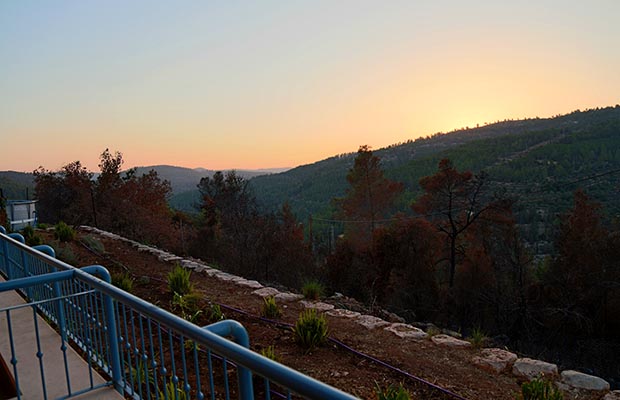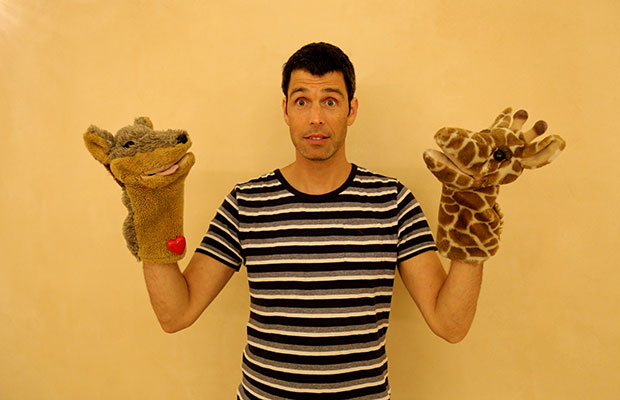Guest post by Ayo Oppenheimer-Abitbol
“What a bombshell!” “You da bomb!” – A lot of slang in the English language is derived from military and, at times, violent origins. While we may not be actively thinking about the source of these words when we use them, etymology does influence us in its own subtle way. Israeli culture too features military language in its day-to-day slang, perhaps more so than the United States, with a range of IDF acronyms but also with explosive-related words like petzatza (literally explosion, used to refer to a beautiful woman), rank-related words like aluf (champion) and even words like totach – literally canon, but used to describe an awesome guy, check out Sarit Hadad’s song ‘Ata Totach’ below:
https://www.youtube.com/watch?v=9yVsFL6oMGE).
When I heard that an international leader in Non-Violent Communication (NVC) was coming to Israel to offer training, I was intrigued not only for the opportunity to integrate the content into my acroyoga teaching practice but also for how it would be received by a culture whose modern language has been developed in and influenced by a strong exposure to violence. Israeli culture is direct and, for your average Jewish visitor or Anglo immigrant, it can seem alarmingly confrontational. I wondered how successful a technique like NVC could be in Israeli culture and was intrigued to witness the attempt to repackage Israelis’ overt, forceful and sometimes demanding rhetoric into a more presentable exterior.
I figured that at best, the philosophy could be transformative or at least make day-to-day interactions with the average Israeli a bit more pleasant. At worst, I would have the opportunity to check out the brand new and recently opened Chavat HaIssim (Essene Farm) retreat center that was hosting the weekend. I would soon realize that my understanding of NVC was totally off the mark.
Non-violent communication or, in Hebrew tikshoret mikurevet (compassionate communication) was founded by Marshall Rosenberg (1934-2015) in the early 1960s. The general principle behind the philosophy is that “all human beings have the capacity for compassion and only resort to violence or behavior that harms others when they don’t recognize more effective strategies for meeting needs”.
Israeli-born and Amsterdam-based NVC master Yoram Mosenzon has been involved in nonviolent communication for over 15 years and was the visiting teacher who brought together thirty-four individuals for an NVC journey just last month. Some participants had never heard of the practice whereas others were marking their fifth retreat, not just with NVC, but specifically with Yoram. It was clear that this guy had some followers!
The weekend kicked off with an opening circle, where participants were encouraged to express their authentic selves and the feelings in their body in just a sentence or two. My dear hubby CK, God bless him, is nothing but authentic, sharing that he had spent his entire life avoiding rooms like this and people like this and that he was highly, highly skeptical… but open minded. There was laughter around the room as participants appreciated the humorous honesty, and the workshop had begun!
The first minutes of the program revealed that NVC was much more than simply couching harsh feelings in nice words. The approach wasn’t just a language makeover, but was more about approaching our interactions from a totally new vantage point. Participants were led through a process of:
1) Connecting to their own selves
2) Bringing awareness to their feelings
3) Identifying the underlying needs behind the feelings (harder than it sounds)
4) Crafting a modest and concrete request to meet the need
One woman spoke about the frustration and discouragement of being the homemaker in her family with a constant influx of cleaning, cooking and assorted to-dos. Working through this process in front of the group, she was able to move beyond the general feelings to identify two clear needs: for appreciation and for partnership in running the house. Identifying those needs doesn’t automatically fix the problems, but it was obvious what a sense of relief the clarity brought to her. That clarity and sense of calmness has a much better chance of success at communicating and meeting her needs than the prior exasperation. (Details have been altered to respect the privacy of the participants.)
Yoram’s playful and exploratory teaching style amused and challenged the group who quickly understood that the NVC approach was a lot easier to apply in theory and took a lot of composure to realize in practice! He introduced the idea of the giraffe and the jackal, animal figures that respectively symbolized the kind and empathetic voice within and the selfish, hurt and attacking voice within.
When Yoram first pulled out actual stuffed animals of a giraffe and a jackal, I balked. After all, we were adults and wasn’t it a bit childish or insulting to drag out children’s toys when dealing with such serious issues? But he knew what he was doing. Specifically when we tap into emotionally charged topics that bring up anger and cause the self to close up, it is all the more important to have a visual tool (especially a playful one!) to diffuse the tension and sense of emotional contraction.
The group watched in fascination as Yoram embodied the giraffe voice as the kind, listening and empathetic parts of ourselves and the jackal voice as the selfish, angry, and attacking voice. He modeled conversations in both voices and gave participants the experience of speaking in both ‘giraffe’ and ‘jackal’ and responding to other participants when they embodied each voice. An important parallel process of building empathy and holding space for the other was established alongside the initial path of self-awareness and communication.
There was an acknowledgment that we all not only have different needs, but also different rhythms and that those rhythms will not always align. Yoram stressed that even once there is awareness of our needs, they must be communicated with a request and not a demand. If you expect the other person to acquiesce to your request and create a situation where the person being asked cannot reasonably say no, then you are failing in your request and really issuing an imposing demand.


Beautiful sunset view from the room
The process of tapping into our self-awareness, being willing to be vulnerable and expressing empathy for others is what transforms violent communication into a process that can bring us together. So, it’s not about nicely packaging our speech and making tricky and nicely-worded demands of the other, but rather bringing lucidity to our own needs and taking responsibility for meeting our own needs.
Though the approach seemed solid and though Yoram was a skilled facilitator, I found myself mentally checking out toward the end of the first day. After all, improved communication could certainly help the world, but how was it going to solve day-to-day irksome matters like who does what chores or where to send your kids to school or whether your house should be vegetarian? At the end of the day, there will always be conflicting needs, values and realities, and what did NVC have to say about that?
Luckily, I managed to snag some time that evening with NVC teacher Shira who is one of two or three teachers that facilitate programming in the Jerusalem area. Shira empathized that there is no magic solution or NVC formula to making problems disappear. Her philosophy is that many people live in a world of “shoulds”, which soon become tests and simply create a negative environment.
“You should do the dishes” soon becomes a daily test. Did she do the dishes today? If she didn’t, it’s a self-fulfilling prophecy that validates the judgment in the first place. If she did, then the test simply continues the next day and the day after and after that, always waiting to be proven right and setting up your partner to fail.
Shira shared her view that by communicating mindfully and directly actually arouses empathy in the other to want to support you in your needs. Being in a place of connection and empathy creates a desire to do what is possible to help the other meet their needs. Does it guarantee the desired outcome? No, but seemingly the development of connection and understanding naturally leads the gap between conflicting desires to become smaller. Local therapist and facilitator Danny Cohen puts it into shorthand for us with his remark that ‘Intimacy doesn’t mean agreeing’, a simple yet powerful statement.
We are now in the midst of the Jewish high holiday season, a time of reflection to take stock of the relationships around us and how we relate, verbally and emotionally, to those who we love more and also to those who we love less.
NVC can be a powerful tool to study, embrace and practice for a more whole, more kind and more compassionate 5776. Wishing you all a Shanah Tovah / Happy New Year!
*To learn more about NVC, check out nonviolentcommunication.com
*To check out more about Yoram Mosenzon, check out connecting2life.net/yoram-mosenzon
*Essene Farm, is a resort center located just outside of Jerusalem in a quaint village called Even Sapir. The location is surrounded by the Jerusalem Forest, features 6 sustainably-designed tsimmers (private cabins) and is within walking distance of a natural spring.
- A Pesach Story: How Jesus and a Donut Sent me to Israel - 4/14/2022
- The Queen’s Gornisht - 4/20/2021
- Introducing Nicole Raviv. - 11/14/2020






Elwehb cialis effet avis [url=https://newfasttadalafil.com/]cheapest place to buy cialis[/url] Sale Generic Free Shipping Clobetasol Dqldqw cialis online no prescription viagra cuanto cuesta Wsqbwq https://newfasttadalafil.com/ – viagra and cialis online Xphqdo
Has anyone ever been to Ironsides Vape Shop LLC Ecig Shop in 6616 washington Ave Suite F?